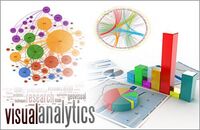Lesson 5
Jump to navigation
Jump to search
|
|
|
|
|
|
Visualising and Analysing Multivariate Data
Contents
Content
- Introduction to Multivariate Data
- Trellis
- Correlation Matrix
- Ternary Plot
- Glyphs or Star Plot
- Heatmap
- Parallel Coordinate Plot
- Treemap
Readings
Core Readings
- An Introduction to Visual Multivariate Analysis
- Corrgrams: Exploratory Displays for Correlation Matrices
- Ternary Plot
- Multivariate Data Glyphs
- Parallel Coordinates
- Wikipedia: Heatmap
Optional Readings
- The scatter-plot matrix: a great tool
- A Graphical Display of Large Correlation Matrices
- Ternary Diagram
- Reading a Ternary Diagram
- Multidimensional Detective
- Parallel Coordinates
- Multivariate Analysis Using Parallel Coordinates
R Methods
Ternary Plot
- R packages for creating ternary plot
Heatmap
- Using R to draw a Heatmap from Microarray Data
- R packages for creating heatmap
- heatmap() [R base function, stats package]: Draws a simple heatmap.
- heatmap.2() [gplots R package]: Draws an enhanced heatmap compared to the R base function.
- pheatmap() [pheatmap R package]: Draws pretty heatmaps and provides more control to change the appearance of heatmaps.
- Heatmap() [ComplexHeatmap R/Bioconductor package]: Draws, annotates and arranges complex heatmaps (very useful for genomic data analysis)
- Superheatmap
- d3heatmap() [d3heatmap R package]: Draws an interactive/clickable heatmap
